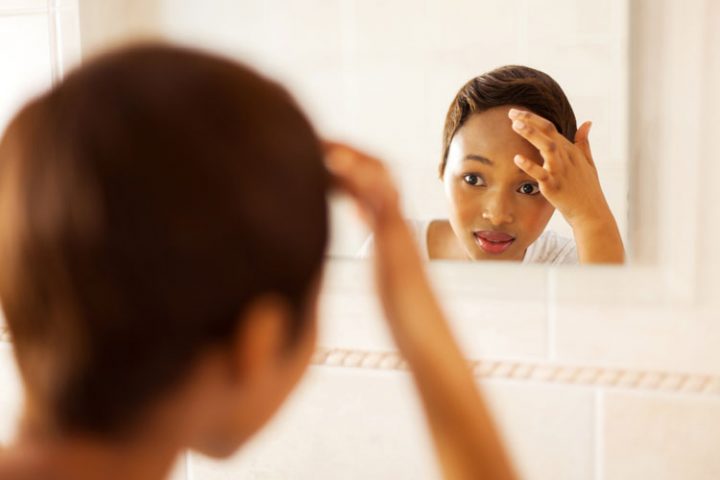
Acne is more common in adolescents but adults even in their forties can be affected. Adult acne has increased substantially over the last twenty years, and I’m going to explain how to effectively address this skin concern.
DIET
Our dietary habits have proven to have direct correlations to acne. Particularly from the higher levels of refined sugars and hormones present in many foods we eat. There is no magical dietary cure for acne. However the best solution is to avoid sugar, refined carbs and dairy, and consume an antioxidant-rich, plant-based diet with lean animal protein. Read more about suitable diet for acne suffers in my blog ‘Addressing Acne From The Inside Out’ or watch me chat through it in my video here.
STRESS LEVELS
Another factor is stress. Stress increases the body’s level of cortisol which has a direct action on the oil gland. Reducing stress with exercise and meditation is an excellent way of addressing spiked oil production. Read more on this in my blog ‘Are You Stressing Out Your Skin’.
ENLARGED PORES
Enlarged pores cause your skin to be more prone to breakouts. Addressing pore size starts with understanding why they occur:
- Hereditary: genetics and race play a role in pore diameter. Generally Asian skin is prone to larger pores compared to Caucasian skin types.
- Excess oil and clogged pores: Individuals with acne have overly active oil glands. When excess oil and dead skin clogs the pores they become enlarged and more visible. A blackhead is actually an enlarged pore filled with oil that has oxidised (blackened) at the surface and a whitehead is an enlarged pore filled with oil that is not exposes to the air.
- Acne scarring: when pores are enlarged and inflamed for a long period, the pore may become permanently enlarged and not spring back to its original size even after the acne is cleared. This is a form of low-grade scarring.
- Ageing and sun damage: The skin that surrounds the pore contains collagen and elastin to maintain structure and elasticity. As our skin ages or is damaged but UV light the skin surrounding the pores becomes ‘slack’ and stretched a bit like an over stretched elastic band that does not do back to its original form. As a result the skin around the pores becomes larger and more visible as reduced collagen production means the skin is not as well supported.
HORMONE IMBALANCES
All acne is based on hormonal imbalance. Polycystic Ovarian Syndrome (PCOS) is a hormonal disorder that is a common cause of adult acne.
Persistent adult acne should be addressed by a dermatologist and endocrinologist to determine how to appropriately address the skin’s hormone imbalance. Topical skincare, clinical treatments, and hormone balancing medications are all effective options.
CLINICAL TREATMENTS
Ensure you are treated by a qualified aesthetician or medically trained clinician. You must have a treatment that is suited to your individual skin type and concern. Acne management is not a ‘one-size-fits-all’ treatment. Clinical treatments include:
- Lactic acid and/or Salicylic acid peels
- Jessner Peels
- Microdermabrasion
- Galvanic infusion of AHA’s, BHA’s and L-ascorbic acid
- PDT (Photodynamic Therapy) performed by a qualified medically trained therapist
TOPICAL SKINCARE
Reduce the opportunity for acne and blocked pores to occur by using clinical grade skin ingredients
- AHA’s and BHA’s to remove dead skin build-up and debris trapped in the pores (present in Synergie Skin ReVeal and Blem-X)
- Retinol (Vitamin A) to reduce excess oil production (Synergie Skin Ultimate A)
- Niacinamide (Vitamin B3) to reduce oil and inflammation (Synergie Skin Vitamin B)
- L-ascorbic acid (Vitamin C) to stimulate collagen and reduce inflammation (Synergie Skin Pure-C crystals)
- Use ingredients to minimise the appearance of enlarged pores. A new botanical ingredient called Barosma Betulina Leaf Extract has been clinically proven to reduce pore volume and diameter (Synergie Skin Evapore-8)
- Ensure the skin is thoroughly cleaned each day to remove clogging oils and dirt. Avoid daily use of toners containing alcohol as this can dry out and irritate the skin. Use a gentle SLS-free cleanser twice daily (Synergie Skin UltraCleanse)
- Ingredients to reduce bacteria in the pores. Some natural essential oils such as Manuka and lemongrass are excellent at addressing acne bacteria
- Avoid moisturisers that are too rich and may be high in comedogenic oils. Oil-free moisturisers are ideal. (Synergie Skin HydroGel)
- Use non-comedogenic mineral makeup and avoid makeup containing oils that can clog pores. Mineral makeup containing zinc oxide doubles as a natural skin soother and UV protector (Synergie Minerals)
- Apply broad-spectrum sun protection daily (preferably based on zinc oxide mineral sunblock) to prevent UV light breaking down the structural support network around the pores (Synergie Skin ÜberZinc)
THE ROUTINE:
DAY
- UltraCleanse – gel facial cleanser
- ReVeal – exfoliating serum
- Pure-C crystals – pure L-Ascorbic acid
- Blem-X – acne and blemish spot serum
- ÜberZinc – moisturiser with 21% zinc oxide
NIGHT
- UltraCleanse – gel facial cleanser
- EvaPore-8 – gentle pore-refining tonic
- Ultimate A – stabilised retinol serum
- Vitamin B – essential niacinamide serum
- HydroGel – light hydrating gel
WEEKLY
- MediScrub – facial scrub
- Detox anTiox – purifying detox mask
OCCASIONAL
- BAcne – body blemish serum
For an introductory set, we recommend the Synergie Skin Blemish Control Kit, a targeted mini kit for those with blemish-prone skin.
